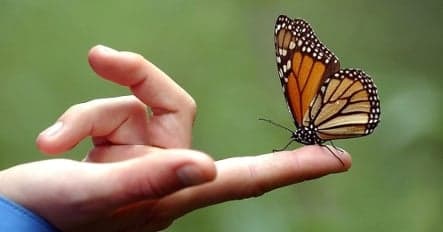German mini tracker chip tracks butterfly migration

German scientists have managed to make a radio transmitter so small that they can use it to track the migration of monarch butterflies.
The group is working in the United States, sticking the tiny transmitters onto the butterflies and then following them on their migration northward.
Martin Wikelski, a biologist from the Max Planck Institute for Ornithology, has already tracked a number of different species, including birds, turtles, dragonflies and bats with small transmitters.
He has conducted tests on monarch butterflies bred in the butterfly house on Germany's Mainau island in Lake Constance and is now ready to take his chip transmitter out into the wild.
He is working with filmmakers from National Geographic, to track the monarch butterflies as they embark on their annual multi-generational pilgrimage between the Canadian side of the Great Lakes and Mexico.
The scientists, including Chip Taylor, director of the organisation ‘Monarch Watch’ at Kansas University, make sure they feed the butterflies before releasing them with the chip glued to their bodies. The chips weigh half as much as the butterflies themselves, so carrying one is an effort.
They are currently working in Kansas, fine-turning their sticking-on and tracking techniques. The first insect subject flew for more than 11 miles in the expected direction, with the scientists following in a car. Others fitted with the transmitters will be followed by planes.
The data will be entered into the Movebank, a databank which contains global animal and insect migration information, which is available to environmental conservationists as well as schools.
Millions of the monarch butterflies form swarms in the mountains of Mexico in March, and head north. By April they are at the Rio Grande on the border with the US, where the females lay the first of their 400 eggs.
By May the butterflies are in Texas where they die. Their young continue the journey northwards, and by the time butterflies reach Canada, they are the three generations removed from the insects which left Mexico.
The return trip is undertaken by just one generation, travelling around 7,000 kilometres in the late autumn back to Mexico.
Comments
See Also
The group is working in the United States, sticking the tiny transmitters onto the butterflies and then following them on their migration northward.
Martin Wikelski, a biologist from the Max Planck Institute for Ornithology, has already tracked a number of different species, including birds, turtles, dragonflies and bats with small transmitters.
He has conducted tests on monarch butterflies bred in the butterfly house on Germany's Mainau island in Lake Constance and is now ready to take his chip transmitter out into the wild.
He is working with filmmakers from National Geographic, to track the monarch butterflies as they embark on their annual multi-generational pilgrimage between the Canadian side of the Great Lakes and Mexico.
The scientists, including Chip Taylor, director of the organisation ‘Monarch Watch’ at Kansas University, make sure they feed the butterflies before releasing them with the chip glued to their bodies. The chips weigh half as much as the butterflies themselves, so carrying one is an effort.
They are currently working in Kansas, fine-turning their sticking-on and tracking techniques. The first insect subject flew for more than 11 miles in the expected direction, with the scientists following in a car. Others fitted with the transmitters will be followed by planes.
The data will be entered into the Movebank, a databank which contains global animal and insect migration information, which is available to environmental conservationists as well as schools.
Millions of the monarch butterflies form swarms in the mountains of Mexico in March, and head north. By April they are at the Rio Grande on the border with the US, where the females lay the first of their 400 eggs.
By May the butterflies are in Texas where they die. Their young continue the journey northwards, and by the time butterflies reach Canada, they are the three generations removed from the insects which left Mexico.
The return trip is undertaken by just one generation, travelling around 7,000 kilometres in the late autumn back to Mexico.
Join the conversation in our comments section below. Share your own views and experience and if you have a question or suggestion for our journalists then email us at [email protected].
Please keep comments civil, constructive and on topic – and make sure to read our terms of use before getting involved.
Please log in here to leave a comment.